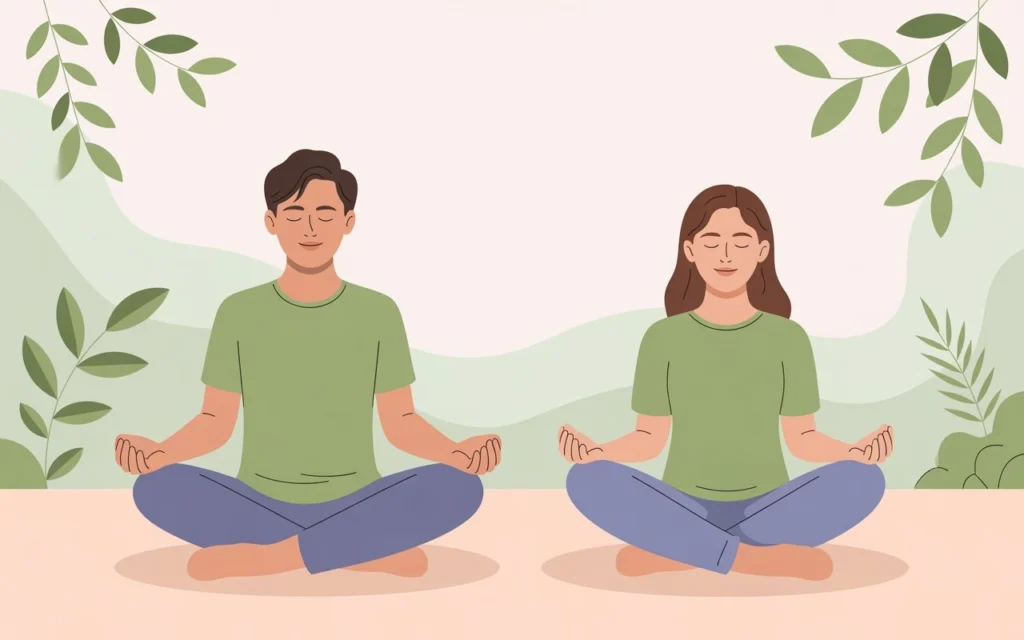There’s a particular kind of loneliness that happens when anxiety crashes into a relationship like an uninvited guest. You’re sitting right next to your partner on the couch, physically close enough to touch, but your mind is spiraling through tomorrow’s worries, last week’s unresolved argument, or imagining catastrophes that haven’t happened yet. Meanwhile, they’re talking about their day, and you realize you haven’t heard a single word. The guilt hits hard—another moment lost to the relentless chatter of an anxious mind.
This scenario plays out in countless relationships every single day. When anxiety takes the driver’s seat, presence becomes nearly impossible. The person you love most feels the distance, even when there isn’t any physical space between you. They might ask, “Where did you go?” and the honest answer is complicated—somewhere between the what-ifs and the should-haves, trapped in a mental maze that has nothing to do with the present moment unfolding right in front of you.
Here’s something that took years to understand through personal struggle and working with anxious couples: the solution isn’t trying harder to pay attention or beating yourself up for being distracted. The answer lies in cultivating mindfulness together—not as some trendy buzzword or quick fix, but as a genuine spiritual practice that brings both peace and connection. Scripture tells us in Philippians 4:6-7 to bring our anxieties to God through prayer and thanksgiving, and mindfulness becomes a practical way to live out that invitation. When couples learn to be present together, anxiety loses some of its power to create distance.
Understanding How Anxiety Creates Distance
Anxiety doesn’t just affect the person experiencing it—it ripples through the entire relationship like stones thrown into still water. When one partner struggles with anxious thoughts, the other often feels shut out, helpless, or even inadvertently blamed for not understanding. The anxious partner, meanwhile, carries shame about their inability to “just relax” or “be normal,” which only feeds the cycle.
What makes this particularly painful is that anxiety often targets the very thing you cherish most. When you deeply love someone, your mind can weaponize that love, creating worst-case scenarios about losing them, disappointing them, or somehow destroying the relationship. The cruel irony is that anxiety about the relationship can actually damage it—not because the love isn’t real, but because presence becomes impossible when you’re mentally rehearsing disasters that haven’t happened.
Physical symptoms complicate things further. Anxiety isn’t just mental—it manifests as a racing heart, shallow breathing, tense shoulders, and a nervous stomach. These bodily sensations make it genuinely difficult to stay grounded in the moment. Your partner might suggest a date night, and instead of enjoying their company, you’re hyper-aware of your pounding heartbeat, wondering if something is physically wrong with you. The body’s alarm system keeps firing even when there’s no real danger, keeping you locked in fight-or-flight mode when what you really need is rest-and-connect mode.
Many couples fall into unhelpful patterns without realizing it. The anxious partner might seek constant reassurance, asking the same questions repeatedly: “Are we okay? Are you sure you’re not mad? Do you still love me?” While understandable, this can exhaust both people. The non-anxious partner might respond with logic—”We’ve talked about this already, everything is fine”—not understanding that anxiety doesn’t respond to logic. Or they might walk on eggshells, avoiding topics that might trigger worry, which creates its own kind of distance.
The Biblical Foundation for Present-Moment Awareness

God’s design for relationships includes being fully present with one another. When Jesus walked this earth, notice how He gave people His complete attention. Whether healing the woman who touched His garment in a crowd or having dinner with tax collectors, He was remarkably present. In Mark 5, amid the pressing crowd, Jesus stopped everything when one woman reached out in faith, asking “Who touched me?” That’s presence—the ability to notice and respond even in chaos.
The concept of mindfulness actually aligns beautifully with biblical teaching, though it goes by different names in Scripture. When Psalm 46:10 says “Be still and know that I am God,” that’s an invitation to present-moment awareness grounded in God’s presence. When Jesus taught His disciples not to worry about tomorrow in Matthew 6:34, He was essentially teaching mindfulness—staying anchored in today rather than catastrophizing about the future.
The word “watch” appears throughout Scripture, inviting believers to be alert and aware. First Peter 5:8 encourages vigilance, not as anxious hypervigilance, but as calm, grounded awareness. There’s a profound difference between the two. Anxious hypervigilance means constantly scanning for threats, exhausting yourself with worry. Biblical watchfulness means being present and aware while trusting God’s sovereignty—resting in His care while remaining engaged with reality.
Practicing mindfulness together as a couple can become a form of prayer—an acknowledgment that God is present in this moment, in this conversation, in this shared breath. It’s choosing to receive the gift of now rather than mentally living in the regrets of yesterday or the fears of tomorrow. This doesn’t mean ignoring legitimate concerns or failing to plan wisely. It means learning to discern when you’re problem-solving versus when you’re just spinning your wheels in worry.
Creating Mindful Moments Throughout Your Day
Mindfulness doesn’t require hour-long meditation sessions or perfect silence (though those can be wonderful). For busy couples managing work, maybe kids, and all of life’s demands, mindfulness works best when woven into ordinary moments. The goal is building a habit of returning to the present together, again and again.
Morning connection rituals set the tone for the entire day. Instead of both partners immediately reaching for phones upon waking, try spending just two minutes making actual eye contact and taking three deep breaths together. This simple practice signals to your nervous systems that you’re safe, connected, and starting the day as a team. Some couples add a brief prayer here, inviting God into their day before the chaos begins. The beauty is in the consistency, not the duration—two mindful minutes beats a distracted hour every time.
Mindful greetings when reuniting after work can transform evenings. Anxiety often peaks during transitions, and coming home after a stressful day can feel overwhelming. Instead of immediately launching into logistics—”Did you pick up milk? What’s for dinner? Did you see that email?”—pause for a genuine hello. A six-second hug (research shows this is the minimum time needed for oxytocin release) with focused attention does more for connection than an hour of distracted coexistence. Put phones down, make eye contact, and actually notice each other.
Mealtime offers built-in opportunities for presence. Instead of eating while scrolling through devices or watching TV, try mindful eating together a few times a week. Notice the flavors, textures, and colors of food. Thank God for the provision and for each other’s company. Share one thing you each noticed during the day—not just events, but actual sensory experiences. This practice naturally slows down the anxious mind, which tends to race ahead or ruminate backward.
Evening wind-down routines help anxious minds settle before bed. The hour before sleep is when anxiety often intensifies—lying in the dark, nothing to distract from worries. Create a ritual together: dim the lights, play soft music, maybe sip herbal tea while sitting close. Take turns sharing three things from the day—no problem-solving or advice-giving, just listening. End with a simple prayer, releasing worries and inviting peaceful rest. This predictable routine becomes a signal to your nervous system that it’s safe to relax.
Breathing Techniques That Calm Together

Breath is the bridge between body and mind, and it’s also something couples can sync together. When anxiety strikes, breathing becomes shallow and rapid, sending distress signals throughout the body. Intentionally slowing and deepening breath together not only calms individual nervous systems but also creates a sense of unity and shared regulation.
The 4-7-8 breath works beautifully for couples. Sit facing each other or side-by-side with hands touching. Inhale together through the nose for a count of four, hold for seven, exhale through the mouth for eight. The longer exhale activates the parasympathetic nervous system—your body’s brake pedal. Do this for four to five cycles, maintaining gentle eye contact if that feels comfortable. There’s something powerful about breathing in rhythm with someone you love, a non-verbal reminder that you’re not alone in this.
Box breathing offers structure that anxious minds appreciate. Visualize tracing the sides of a square as you breathe: inhale for four counts, hold for four, exhale for four, hold for four. Partners can trace an actual box on each other’s backs or palms while doing this together, adding a tactile element that increases grounding. This technique is particularly helpful during conflicts when emotions run high and presence feels impossible—taking a breathing break together can reset the conversation.
Hand-on-heart breathing brings in the comfort of physical touch. One partner places their hand on their own heart, the other places their hand on top. Feel the heartbeat, notice it gradually slowing as breathing deepens. This practice acknowledges that anxiety has physical components and that soothing touch between partners can actually help regulate the nervous system. Some couples pray while doing this, thanking God for the gift of breath and for each other’s presence in hard moments.
Breath prayers combine ancient spiritual practice with mindfulness. Choose a short phrase from Scripture or a simple prayer, coordinating it with breath. Inhale: “The Lord is my shepherd,” exhale: “I shall not want.” Or inhale: “Be still,” exhale: “and know.” Partners can speak these alternately—one person’s inhale, the other’s exhale—creating a beautiful rhythm of shared faith and presence. This technique is especially grounding during anxious episodes because it gives the mind something true to focus on instead of spinning worry.
The Five Senses Exercise for Couples
When anxiety disconnects you from the present moment, the five senses become your pathway back to now. This exercise can be done together anywhere—at home during a tense moment, in the car before a stressful event, or even walking outside. It’s a practical way to shift from the spinning thoughts in your head to the reality around you.
Start with what you can see. Take turns naming five things you can see right now, being as specific as possible. Not just “the couch” but “the navy blue couch with the throw pillow we bought on vacation.” This specificity matters—it forces your mind to engage with actual present reality rather than abstract worries. When you really look at something, describing its color, shape, and details, anxiety has less room to operate.
Move to what you can touch. Name four things you can physically feel—the texture of your partner’s hand, the cool leather of the chair, the weight of your feet on the floor, the softness of the fabric against your skin. Actually touch these things while naming them. This tactile grounding is incredibly powerful for anxious minds that have drifted into imagined catastrophes. Physical sensation anchors you firmly in this moment, this body, this room.
Listen together for three things you can hear. Maybe it’s the hum of the refrigerator, birds outside, distant traffic, or your partner’s breathing. Close your eyes if that helps. Anxiety often makes the world feel threatening, but pausing to really listen usually reveals a much calmer reality than what’s playing in your head. Sometimes just hearing your partner’s steady breathing can remind an anxious nervous system that there’s safety here.
Notice two things you can smell. This might require some creativity—the lingering scent of coffee, fresh laundry, your partner’s cologne, the earthiness of houseplants. Smell is deeply connected to the limbic system, the emotional center of the brain, which is why certain scents can instantly calm or trigger. Choosing to focus on pleasant, present scents can shift emotional state surprisingly quickly.
Finally, identify one thing you can taste. Maybe it’s the remnants of lunch, the freshness of water, or even just the taste of your own mouth. This completes the circuit of sensory awareness, bringing you fully back to the present moment. After cycling through all five senses, most people find their anxiety has decreased significantly—not because the worries disappeared, but because they’ve reconnected with actual reality rather than imagined threats.
Mindful Communication During Conflict
Conflict is inevitable in relationships, but anxiety can turn disagreements into disasters. When anxious, the nervous system interprets conflict as life-or-death threat, triggering responses that escalate rather than resolve. Mindful communication techniques can help couples stay present with each other even when emotions run high, preventing anxiety from hijacking important conversations.
The pause practice saves countless arguments. When you feel anxiety rising during a discussion—heart racing, thoughts spiraling, the urge to defend or attack—call a mindful pause. This isn’t stonewalling or avoiding; it’s intentionally creating space for both nervous systems to settle. Say something like, “I’m feeling overwhelmed. Can we pause for five minutes?” During the pause, practice breathing techniques or do a quick grounding exercise. Importantly, always return to the conversation after calming—following through builds trust and shows that pausing is about regulation, not avoidance.
Active listening becomes radical presence. When your partner is speaking, anxiety wants you mentally preparing your defense, catastrophizing about where this conversation is heading, or replaying past arguments. Mindful listening means noticing when your mind drifts and gently bringing attention back to your partner’s actual words, tone, and body language. Before responding, take a breath and reflect back what you heard: “What I’m hearing is…” This simple practice slows things down and ensures you’re responding to what’s actually being said, not what anxiety tells you is being said.
“I” statements grounded in present experience reduce defensiveness. Instead of “You always make me anxious” or “You never understand,” try “Right now, I’m feeling anxious and noticing my heart racing. I need a moment to breathe.” This describes present reality without blame or catastrophizing. It’s honest, vulnerable, and invites connection rather than defense. Anxiety loves to speak in absolutes—always, never, everyone, no one—but mindfulness pulls us back to the truth of this specific moment.
The practice of “name it to tame it” helps during emotional flooding. When anxiety overwhelms during conflict, simply naming what’s happening can reduce its intensity. “I notice I’m feeling really anxious right now” or “My fight-or-flight response is kicking in” creates just enough distance to prevent complete emotional hijacking. Partners can help by acknowledging without judgment: “I see you’re feeling anxious. Let’s slow this down together.” This validation is powerful—anxiety thrives in isolation but weakens when acknowledged and shared.
Building a Daily Mindfulness Practice Together
Individual mindfulness practices are valuable, but couples who cultivate presence together often experience deeper connection and better anxiety management. Creating shared rituals doesn’t require extensive time—consistency matters far more than duration. Even five minutes daily of intentional presence together can transform a relationship.
Morning gratitude sharing sets a positive, grounded tone. Before the day’s demands intrude, share three specific things you’re grateful for—at least one about your partner or relationship. Not vague generalities like “I’m grateful for you,” but present-moment specifics: “I’m grateful you made coffee this morning and brought me a cup” or “I appreciate how you listened last night when I was worried about work.” This practice trains anxious brains to notice what’s right instead of constantly scanning for threats.
Mid-day check-in texts bring mindfulness into busy schedules. Set a reminder for both partners to pause at the same time daily—maybe lunch hour—and send a brief, present-moment message. Not “How’s your day?” but something more grounded: “Right now I’m noticing the sunshine through my office window and thinking of you” or “Taking a breath and remembering we’re on the same team.” These micro-moments of connection combat anxiety’s tendency to create distance and imagined problems during time apart.
Evening gratitude walks combine physical movement with presence. Walking side-by-side naturally regulates nervous systems, and adding conversation about the day’s small blessings creates positive bonding. The key is keeping it sensory and specific—what you saw, heard, tasted, felt, or smelled that brought a moment of peace or joy. This isn’t forced positivity that ignores real struggles; it’s choosing to also notice the good that anxiety often blinds us to.
Bedtime loving-kindness meditation tailored for couples can transform sleep quality for anxious minds. Lying in bed, one partner guides while both participate, or trade off nights. Start by placing a hand on your own heart, then on each other’s hearts. Silently or aloud, offer blessings: “May you rest peacefully tonight. May anxiety release its grip. May you know how deeply loved you are. May God’s peace guard your heart and mind.” This practice, rooted in both mindfulness tradition and biblical concepts of blessing, provides security and connection right when anxiety often spikes.
When One Partner Is More Anxious
In many relationships, one partner struggles significantly more with anxiety while the other tends toward steadiness. This dynamic can be challenging—the anxious partner might feel like a burden, while the steadier partner might feel overwhelmed by constant reassurance-seeking. Mindfulness offers a way forward that honors both people’s experiences.
The steadier partner’s role isn’t to fix their anxious partner but to be a grounding presence. Think of yourself as an anchor—not rigid or unmovable, but steady enough to provide stability when anxiety creates internal turbulence. This means staying calm during your partner’s anxious moments without dismissing their feelings or trying to logic them out of worry. Your regulated nervous system can actually help regulate theirs through proximity and presence, but only if you don’t become anxious about their anxiety.
Co-regulation happens when two nervous systems influence each other. When one partner is highly anxious and the other remains calmly present—not distant or cold, but peacefully engaged—the anxious partner’s system gradually settles. This doesn’t happen instantly or perfectly, but over time, an anxious person learns that their partner’s steadiness is trustworthy. Practically, this looks like making eye contact, speaking in a slightly slower and softer tone, and using gentle touch if the anxious partner finds that helpful (some do, some don’t during acute anxiety).
The anxious partner’s responsibility is learning self-regulation skills, not depending entirely on their partner for anxiety management. This is crucial—while partnership means supporting each other, one person cannot be another’s sole source of calm. Working with a therapist, developing personal mindfulness practices, and taking responsibility for your own emotional health protects the relationship from becoming defined by anxiety. When you notice yourself seeking reassurance for the third time about the same worry, that’s a signal to use your own grounding techniques first.
Creating agreements during calm moments prevents misunderstandings during anxious ones. Discuss together: What helps when anxiety strikes? What doesn’t help even though it seems like it should? Does the anxious partner want space or closeness? Is there a code word for “I need help grounding right now” versus “I need to work through this alone”? These conversations, held when both people are regulated and present, create a roadmap for navigating anxiety together without resentment building.
Spiritual Practices That Enhance Mindfulness
Faith and mindfulness aren’t competing approaches—they’re beautifully complementary. Many traditional Christian spiritual practices are actually forms of mindfulness, teaching believers to be present with God and attuned to His work in the moment. Couples can deepen both their spiritual life and their relationship presence through these ancient practices.
Lectio Divina, or divine reading, brings Scripture into present-moment awareness together. Choose a short passage, perhaps one about peace or God’s faithfulness. Read it aloud slowly, then sit in silence for a minute, noticing what word or phrase caught your attention. Share with each other what stood out, without explanation or teaching—just noticing. Read the passage again, sit in silence again, notice again. This practice pulls couples out of anxious rumination and into awareness of God’s living word speaking into this moment.
The examen, a prayer practice developed by St. Ignatius, reviews the day with grateful awareness. Each evening, sit together and walk through the day: Where did you notice God’s presence? When did you feel most alive and present? When did anxiety or distraction pull you away from the moment? Where did you see God working despite worry? This isn’t about judging yourself or each other, but about cultivating awareness of God’s constant presence—even in, perhaps especially in, anxious moments. Ending with thanksgiving for specific experiences grounds both people in gratitude rather than worry.
Contemplative prayer creates space to simply be in God’s presence together. Unlike intercessory prayer (asking for things) or praise (celebrating who God is), contemplative prayer is about resting in God’s presence with quiet minds. Sit together in comfortable silence for even five minutes, returning attention to a sacred word or phrase—”Jesus,” “Peace,” “I am loved”—whenever thoughts wander. Anxiety hates silence because it leaves space for worry, but contemplative prayer transforms that space into awareness of God’s loving presence. When practiced regularly with your partner, it creates profound intimacy.
Praying Scripture together combines biblical truth with present-moment awareness. Take verses that counter anxious thoughts—Philippians 4:6-7, Psalm 94:19, Isaiah 41:10—and slowly pray them together, personalizing the words. Instead of racing through, linger on each phrase, letting truth sink past anxious defenses into your hearts. Hold hands while doing this, creating physical connection that reinforces spiritual truth. When anxious thoughts arise later, these embodied prayers become accessible resources because they were planted mindfully, not just recited mechanically.
Overcoming Common Obstacles
Even with the best intentions, couples face challenges when trying to practice mindfulness together. Anticipating these obstacles and having strategies ready increases success and prevents discouragement.
One partner being more enthusiastic than the other creates potential tension. Maybe one person dives into mindfulness practices while the other feels skeptical or overwhelmed. Honor different comfort levels—don’t force participation or make it another source of relationship stress. Start with tiny, non-threatening practices like the morning gratitude share or brief hand-holding before meals. Let the benefits speak for themselves rather than evangelizing about mindfulness. Sometimes the steadier partner is skeptical until they experience how these practices actually help their anxious partner, then buy-in increases naturally.
Time scarcity feels like a legitimate barrier in busy lives. The secret is that mindfulness doesn’t require adding more to your schedule—it’s about bringing fuller attention to moments you’re already sharing. Dishes can be washed mindfully. Commutes can include breathing practices. Bedtime routines already exist; they just need intentionality added. If even two minutes feels impossible, that’s a signal about life pace that deserves attention in itself. Jesus withdrew to quiet places regularly, even when crowds pressed in with demands. Rest and presence aren’t luxuries—they’re necessities.
Old patterns and automatic reactions don’t change overnight. You’ll forget to pause during conflict. You’ll pick up your phone instead of making morning eye contact. Anxiety will still hijack conversations. That’s normal, not failure. Mindfulness is called a practice precisely because it requires ongoing practice, not perfect execution. When you notice you’ve been mentally absent from your partner, just notice it with compassion and return to presence. God’s mercies are new every morning, and so is your opportunity to choose awareness over anxiety-driven autopilot.
Serious anxiety disorders might need professional support alongside mindfulness. If anxiety regularly creates intense distress, involves panic attacks, leads to avoidance of normal activities, or significantly impacts relationship functioning, please consult a therapist or counselor. There’s no shame in this—just as you’d see a doctor for a broken bone, mental health deserves professional care. Mindfulness practices beautifully complement therapy and sometimes medication, but they’re not always sufficient alone. The couples who thrive are often those who wisely pursue all available resources rather than trying to bootstrap their way through serious struggles.
Moving Forward Together
Anxiety creates distance even when two people desperately want closeness. But mindfulness—practiced consistently, gently, and together—offers a pathway back to genuine presence. Not perfect presence, because perfection isn’t the goal or even possible. The goal is simply returning to now, again and again, choosing to be here with this person you love rather than lost in the maze of anxious thoughts.
This journey requires patience and grace—toward yourself, your partner, and the process. Some days will feel like enormous progress. Others will feel like starting over. That’s the nature of growth, especially when rewiring anxious patterns that developed over years or even decades. Keep showing up anyway. Keep breathing together. Keep choosing presence over perfection.
Remember that God meets us in the present moment. Not in yesterday’s regrets or tomorrow’s worries, but in the sacred now. When you practice mindfulness with your partner, you’re not just managing anxiety—you’re creating space to encounter God’s peace together. You’re building a relationship characterized by awareness, connection, and genuine presence rather than one defined by worry and distance.
Start tonight with something simple: before bed, hold hands, take three deep breaths together, and share one thing you appreciated about each other today. That’s all. Then tomorrow, do it again. And the day after that. Small practices, repeated with consistency and love, create profound transformation over time.
The peace that passes understanding—the peace Paul promises in Philippians 4:7—guards hearts and minds in Christ Jesus. It’s available right now, in this present moment, as you and your partner learn to truly be together. Anxiety will likely remain part of your story, but it doesn’t have to write the ending. Through mindfulness grounded in faith, presence becomes possible. Connection deepens. And slowly, steadily, peace finds its way back into the relationship anxiety tried to steal.
You don’t have to do this perfectly. You just have to keep showing up for each other, present and available, breath by breath, moment by moment, trusting that God works through small, faithful practices to create something beautiful.



